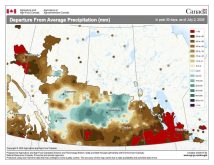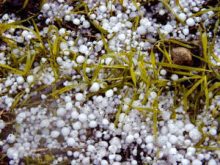By an overwhelming amount, the No. 1 question I have had over the last couple of weeks is: What will the spring be like? While I usually wait until the end of the month to do the look-ahead forecast, I will use this article to go through each of the medium- and long-range forecasters to see what they are predicting. As usual, I will throw in my two cents, but remember, if anyone could accurately predict the weather one to three months in advance, they would be rich. Just think about it: If you knew with certainty what the weather would be like for April, May and June, just what kind of an impact would that have on agriculture?
Read Also

Thunderstorms and straight-line winds
Straight-line winds in thunderstorms can cause as much damage as a tornado and are next on our weather school list exploring how and why severe summer weather forms.
So, why do we try to create these types of forecasts? First, if you don’t try then you will never be able to do it. Second, they’re what I call the fun factor, or maybe a better word is “competition.” Just who will be able to get bragging rights that they had the best forecasts? This is often what ultimately drives innovation.
I will begin the spring forecasts with what some people will argue is the most reliable forecast, but I will argue is one of the least reliable: the almanacs. The biggest issue I have with the almanacs is that they create a single forecast that covers southern and central Manitoba, Saskatchewan and Alberta. With such a large area to cover, a general forecast will undoubtedly miss some major details. On the positive side, at least from the almanacs’ point of view, some place will likely have the weather they forecasted! Looking first at the Old Farmer’s Almanac, it calls for slightly colder-than-average temperatures in April along with well-above-average amounts of precipitation. Temperatures in May and June are forecast to be near average, with slightly below average amounts of precipitation in May and slightly above-average amounts in June. Looking at the Canadian Farmers’ Almanac, which is even more difficult to interpret than the Old Farmer’s Almanac, it appears to call for near- to slightly above-average temperatures in April with near- to slightly below-average amounts of precipitation, as it mentions fair and pleasant weather several times. May looks as if it will be cool and wet as it mentions severe thunderstorms, unsettled, and stormy weather several times. Finally, in June, it seems as if it will be warmer than average, especially in the second half of the month, as it mentions hot weather several times. Precipitation looks to be near average for the month.
Now on to the main U.S. forecaster, the NOAA (National Oceanic and Atmospheric Administration). Unfortunately, its forecast maps and discussions stop right at the U.S. border, but you can look at the maps and extrapolate the data northward, at least into the southern part of the Prairies. According to its just-released spring forecast, it calls for near-average temperatures this spring across Manitoba, with slightly below-average temperatures in Saskatchewan and below-average temperatures in Alberta. Its precipitation forecast is the opposite, with near-average amounts forecast for Alberta, slightly above average in Saskatchewan and above average across southern Manitoba.
The next model is the CFS, or the Climate Forecast System or Coupled Forecast System, and it is a medium- to long-range numerical weather prediction and a climate model run by the National Centers for Environmental Prediction (NCEP). It creates a six-week medium-range forecast along with a month-by-month six-month forecast. Its six-week forecast shows near-average temperatures across the eastern Prairies with predominantly below-average temperatures across western regions. Its precipitation forecast for April calls for near- to slightly above-average amounts. Moving on to May, its longer-range forecast calls for well-above average temperatures across the eastern Prairies transitioning to near-average temperatures as you move west into Alberta. Southern regions are forecast to see above-average amounts of precipitation in May, with near-average amounts over central and northern regions. In June, its forecast calls for above-average temperatures across all three Prairie provinces with the warmest temperatures forecast to be across eastern regions. Along with the warm temperatures, it predicts above-average precipitation across much of Saskatchewan and Alberta with near-average amounts in Manitoba.
Environment Canada calls for above-average temperatures across all three Prairie provinces from April through to June along with near- to slightly below-average amounts of precipitation.
Lastly, my interpretation of the different long-range forecasts favours the CFS model, as this model has been doing a fairly decent job over the last month or so. I think we will see near average temperatures in April across eastern regions with slightly below-average temperatures over western regions. This temperature pattern will remain in place right through to June, with a general warming toward above-average temperatures across all three provinces by the end of June. Precipitation is always difficult, as it only takes one or two severe weather events to go from drought to excessive wetness. If I had to gamble, I would go with a wetter-than-average April transitioning to below-average precipitation by June.



















